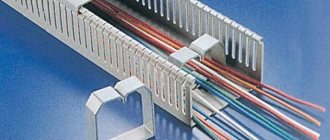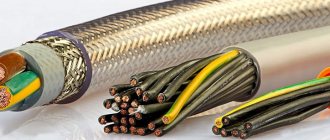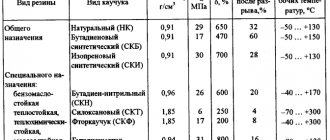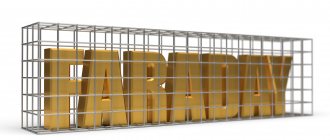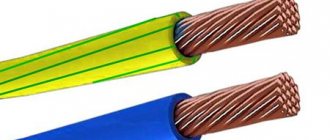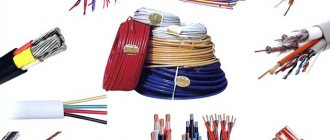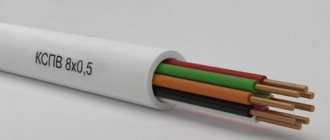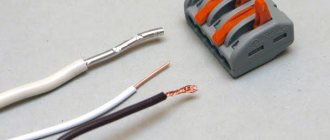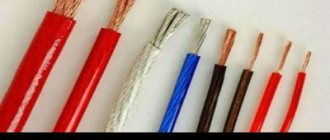Electrical wiring in a house or cottage serves to transport electricity to various types of electricity consumers: lighting fixtures, heaters, boilers, pumps, televisions, etc. All these devices create comfortable living conditions and have a wide range of power consumption from 10 W (shavers, DVDs) to 5 kW (boilers, electric boilers). The role of electrical wires is very difficult to overestimate. Further comfort and safety during operation depends on the correct choice of wire types for various consumer groups at the design and construction stage. Hundreds of meters of wires for various purposes are hidden in the walls of modern buildings, and they are all different - some are thicker, others are thinner, some have two cores, and some have three or more. Each wire has its own purpose (power wiring, lighting, signal cables, telephone cables, Internet) and is responsible for the operation of a particular electrical appliance. Of the many different types of wires and cables, in this article we will look at electrical wires and cables used in construction to transport electricity. Let's consider their varieties, brands and scope of application. Electrical wiring – consists of wires and cables with their associated fastenings, support and protective structures.
Electrical wires are produced in copper and aluminum. Copper wires have better conductivity than aluminum wires, but are also more expensive.
Wires
Wires can be copper or aluminum. Aluminum is very chemically active. If it is connected, it is only with aluminum, and usually mechanically (through nuts and bolts). If aluminum is combined with copper, the connection quickly breaks down. An aluminum wire can be connected to a copper wire through a terminal. If there are no restrictions on weight and price, it is better to use copper wires. The main disadvantage of copper is that it oxidizes in air. The connection point may conduct current less and less well, a voltage drop appears at this point, the connection begins to heat up, to prevent this the connection must be irradiated.
Wire – one uninsulated or one or more insulated conductors, over which, depending on the installation and operating conditions, there may be a non-metallic sheath, winding or braid made of fibrous materials or wire.
Wires can be bare or insulated. Wires can be used for power lines, for the manufacture of electric motor windings, for connections in electronic equipment, etc.
Bare wires do not have any protective or insulated coatings and are mainly used for power lines.
The cores of insulated wires are covered with rubber or plastic insulation.
Wires are classified as protected or unprotected.
Protected wires are insulated wires that have a protective sheath on top of the electrical insulation designed to protect them from external influences.
Unprotected wires do not have a protective sheath over the electrical insulation.
Mounting wires are used for fixed and flexible installation in panels, connections in electronic equipment; current-carrying conductors are made of copper wire.
Power and installation wires are used for installation of electrical wiring. These wires are used for connecting parts of electrical installations and laying them indoors, outdoors, etc.
Cables
A cable is one or more insulated conductors enclosed in a common sealed sheath (lead, aluminum, rubber, plastic), on top of which, depending on the laying and operating conditions, there may be an armor sheath (coating of steel tapes or flat or round wire). Such cables are called armored. Cables without armor are used where there is no possibility of mechanical damage.
By area of application they are divided into the following types:
Power cables are designed for the transmission and distribution of electrical energy in lighting and power electrical installations to create cable lines. They are produced with copper and aluminum conductors with insulation made of paper, PVC, polyethylene, rubber and other materials, and have lead, aluminum, rubber or plastic protective sheaths.
Control cables are used to power various electrical devices with low voltage signals and create control circuits. They can have copper or aluminum conductors with a cross-section from 0.75 to 10mm2.
Control cables are used in automation systems and usually have copper conductors, a plastic sheath and a protective shield that protects against mechanical damage and electromagnetic interference.
Communication cables are designed for transmitting communication signals; they are divided into high-frequency for long-distance communication and low-frequency for local communication lines.
RF cables are used to provide communication between radio devices. They have a coaxial design with a central copper core, which has insulation made of polyethylene or polyethylene, on top of the insulation there is an outer conductor and a sheath of PVC or polyethylene.
Cords
Cord is a wire consisting of two or more insulated flexible conductors with a cross-section of up to 1.5 mm, covered with a non-metallic sheath or other protective coverings. The cord is used to connect electrical household appliances (table lamps, vacuum cleaners, washing machines) to the network. The core of the cord must be multi-wire; in addition, the cores are connected to each other by twisting or a common braid.
Two-core cords are used if the device body does not require protective grounding; if grounding is required, then three-core cords are used.
Differences between wires and cords
Wires, cables and cords vary:
1. According to the material of the current-carrying conductors - copper. aluminum, aluminum-copper.
2. The cross-section of the cores is 0.35; 0.5; 0.75; 1; 1.0; 1.5; 2.5; 4.6; 10; 16; 25; 35; 70 mm2, etc.
3. According to the rated voltage for which the conductors are designed.
3. By the number of cores - single-core and multi-core, from 1 to 4 (control cables from 4 to 61).
4. Insulation - rubber, paper, plastic, yarn
5. On the shell - rubber, plastic, metal.
Thickness of structural elements KSHVGT-10
For a given type of cable, starting from S = 25 mm2 and up to S = 150 mm2, this parameter changes uncritically.
Thickness of elements included in the structure of KShVGT-10
Speaking about the structure, it is worth paying attention to the decoding of the abbreviation of this conductor, it reads like this:
- cable – K;
- mine – Ш;
- high-strength - B;
- flexible – G;
- heat resistant – T;
- number 10 – indicates the value of the rated voltage Unom.
Among other things, the Electrical Installation Rules (ELR) regulate certain requirements for the electrical characteristics of cables.
Marking
Wires and cables are marked with letters.
First letter. Core material: A – aluminum, copper – no letter.
Second letter. In the wire designation: P - wire (PP - flat wire), K - control, M-mounting, MG - mounting with flexible conductor, P(U) or Ш - installation, in the cable designation the sheath material.
Third letter. In the designation of wire and cable - core insulation material: V or VR - polyvinyl chloride (PVC), P - polyethylene, R - rubber, N or NR - nayrite (non-flammable rubber), F - folded (metal) sheath, K - nylon, L - varnished, ME - enameled, O - polyamide silk braid, W - polyamide silk insulation, S - fiberglass, E - shielded, G - with a flexible core, T - with a supporting cable.
The rubber insulation of the wire can be protected by sheaths: B - polyvinyl chloride, N - nayrite. The letters B and H are placed after the designation of the wire insulation material.
Fourth letter. Design features. A - asphalted, B - armored tapes, G - flexible (wire), without protective cover (power cable), K - armored with round wires, O - braided, T - for installation in pipes.
In addition to letter designations, brands of wires, cables and cords contain digital designations: the first digit is the number of cores, the second digit is the cross-sectional area, the third is the rated voltage of the network. The absence of the first digit means that the cable or wire is single-core. The cross-sectional areas of the cores are standardized. The values of the cross-sectional areas of the wires are selected depending on the current strength, the material of the cores, and laying conditions (cooling).
The designation of cords must include the letter Ш.
Designation examples:
PPV 2x1.5-380 – copper wire, with PVC insulation, flat, two-core, core cross-sectional area 1.5 mm, voltage 380 V.
VVG 4x2.5-380 - cable with copper conductors, in PVC insulation, in a PVC sheath, without protective cover, 4-core, with a core cross-sectional area of 2.5 mm, for a voltage of 380 V.
Core cross-section
In order to determine the cross-section of the wire, you need to know its diameter. To do this, use a special tool - a caliper or micrometer.
Flexible cable channel
Diameter and cross-section are not the same thing. Since a round conductor has a circle in its cross-section, the cross-section S, measured in mm2, is calculated using the formula. The formula for calculating S is:
S = (π/4)*D2, where:
- D – diameter of an individual conductor (core), mm;
- π – 3.14.
The total cross-section of the cable (sq. mm) is the result of the summation of the individual cross-sections of all conductors included in it. So, for electrical power cables:
Stotal = S1 + S2 +…+Sn,
Where:
- Stotal – total cross-sectional value;
- S1, S2, …, Sn – transverse dimensions for each element.
This rule is valid for cores consisting of individual wires. To find out S in this case, it is necessary to add up the cross sections of all the wires. When measuring with a caliper, it is recommended to rotate the object and take at least three measurements, and then calculate the arithmetic average of the obtained values. This measure is due to the fact that the conductor is not perfectly round, and it is worth eliminating the error.
Interesting. To calculate S of non-circular conductors, for example, segmented, it is worth using tables for calculating the S sector of an electrical conductor.
In the case of flexible wires, the core is always multi-wire and has an almost round shape.
Table of cross-sections of copper conductors
Decoding the markings of Russian-made wires and cables
Power cables with PVC and rubber insulation.
AC - aluminum core and lead sheath. AA - aluminum core and aluminum sheath. B - armor made of two steel strips with an anti-corrosion coating. BN - the same, but with a non-flammable protective layer. B - the first (in the absence of A) letter - PVC insulation. B - the second (in the absence of A) letter - PVC shell. G - at the end of the designation - there is no protective layer over the armor or shell. Shv - a protective layer in the form of an extruded PVC hose (shell). Shp - a protective layer in the form of an extruded hose (shell) made of polyethylene. K - armor made of round galvanized steel wires, on top of which a protective layer is applied; if K is at the beginning of the designation, a control cable. C - lead sheath. O - separate shells on top of each phase. R - rubber insulation. NR - rubber insulation and a shell made of rubber that does not support combustion. P - insulation or shell made of thermoplastic polyethylene.
PS - insulation or shell made of self-extinguishing, non-flammable polyethylene. PV - insulation made of vulcanized polyethylene. ng - non-flammable.
LS - Low Smoke - reduced smoke emission.
ng-LS - non-flammable, with reduced smoke emission.
FR - with increased fire resistance (mica-containing tape is usually used as a fire-resistant material)
FRLS - with reduced smoke emission, with increased fire resistance
E - screen made of copper wires and spirally applied copper tape
KG - flexible cable.
Control cables.
A is the first letter, then the aluminum core, if it is absent, the copper core. B - second letter (in the absence of A) - PVC insulation. B - third letter (in the absence of A) - PVC sheath.
P - polyethylene insulation.
PS - insulation made of self-extinguishing polyethylene.
G - absence of a protective layer. R - rubber insulation. K - the first or second letter (after A) - control cable. KG - flexible cable.
F - fluoroplastic insulation. E - in the middle or at the end of the designation - shielded cable.
Installation wires.
M - at the beginning of the designation - installation wire.
G - multi-wire conductor; if the letter is missing, then it is single-wire. Ш - polyamide silk insulation. B - polyvinyl chloride insulation. K - nylon insulation. L - varnished. C - fiberglass winding and braiding. D - double braid. O - polyamide silk braid.
Special designations. PV-1, PV-3 - vinyl insulated wire. 1, 3 - core flexibility class.
PVA is a connecting wire in a vinyl sheath.
SHVVP - cord with vinyl insulation, vinyl sheathed, flat.
PUNP - universal flat wire.
PUGNP - universal flat flexible wire.
Wire brands
| Brand | Core cross-section, mm | Number of cores | Characteristic | Application |
| Automatic reclosing | 2,5-120 | 1 | Wire with aluminum core, polyvinyl chloride insulation | For installation of power and lighting networks in pipes and channels |
| APPV | 2,5-6 | 2; 3 | Wire with aluminum conductors, polyvinyl chloride insulation, flat, with dividing base | For installation of power and lighting networks on walls, partitions, hidden wiring, in pipes, channels |
| APR | 2,5-120 | 1 | Wire with aluminum core, rubber insulation, braided with cotton yarn, impregnated with anti-rot compound | For installation in pipes |
| APPR | 2,5-6 | 2; 3 | Wire with aluminum conductors, rubber insulation | For laying on wooden structures of residential and industrial buildings |
| APRN | 2,5-120 | 1 | Wire with aluminum core, rubber insulation, in a non-flammable sheath | For laying in dry and damp rooms, in channels, outdoors. |
| PV-1 | 0,5-95 | 1 | Wire with copper core, polyvinyl chloride insulation | For installation of power and lighting networks in pipes and channels |
| PV-2 | 2,5-95 | 1 | Wire with copper core, polyvinyl chloride insulation, flexible | For installation of power and lighting networks in pipes and channels |
| PPV | 0,75-4 | 2; 3 | Wire with copper cores, polyvinyl chloride insulation, flat, with a separating base | For installation of power and lighting networks on walls, partitions, hidden wiring, in pipes, channels |
| ETC | 0,75-120 | 1 | Wire with copper core, rubber insulation, braided with cotton yarn, impregnated with an anti-rot compound | For installation in pipes |
| PVS | 0,5-2,5 | 2; 3 | Flexible wire, with twisted copper cores, polyvinyl chloride insulation, polyvinyl chloride sheath | For connecting household electrical appliances - washing machines, vacuum cleaners, extension cords |
| PRS | 0,5-4 | 2; 3 | Flexible wire, with twisted copper cores, rubber insulation, rubber sheath | For connecting household electrical appliances - washing machines, vacuum cleaners, extension cords |
| PUNP (PBPP) | 1,5-4 | 2; 3 | Wire with copper core, polyvinyl chloride insulation, polyvinyl chloride sheath | For installation in lighting networks, installation and connection of low current household appliances |
| MGS | 0,05-0,12 | 1 | Installation wire, flexible with copper core, with silk insulation | For stationary and mobile installation of intra-unit and inter-unit connections in electronic and electrical devices |
| MGSHV | 0,12-1,5 | 1 | Installation wire, flexible, with a copper core, with combined silk and polyvinyl chloride insulation | For stationary and mobile installation of intra-unit and inter-unit connections in electronic and electrical devices |
| TRP(noodles) | 0,4-0,5 | 2 | Wire with copper core, polyethylene insulation, with dividing base | For open and hidden wiring of telephone network |
conclusions
If you decide to install electrical wiring in your home yourself, make the correct calculations so that the load does not exceed the permissible one. Keep in mind that in the future you may purchase a new refrigerator, automatic washing machine, dishwasher, toaster, steamer, multicooker, electric oven and other household assistants with high power consumption. Wiring for lighting lamps can be made from simple two-core wires. The automatic washing machine must be connected directly from the distribution board, with a separate cable designed for high current, through a backup disconnect device, with mandatory grounding.
Then decide on the installation location, outline the route, measuring the total length. Buy cables only from certified sellers, taking into account the number of phases, calculated cross-section, and installation method. Go to the store with a caliper to check the thickness of the cores and protective sheaths. Foreign manufacturers often produce cores with a reduced cross-section.
Cable brands
| Brand | Core cross-section, mm | Number of cores | Characteristic | Application |
| AVVG | 2,5-50 | 1; 2; 3; 4 | Power cable, with aluminum cores, polyvinyl chloride insulation, in a polyvinyl chloride sheath | For installation outdoors, along routes protected from direct sunlight |
| AVRG | 4-3002,5-300 | 1; 2; 3; 4 | Power cable, with aluminum cores, rubber insulation, in a polyvinyl chloride sheath | For installation in the air in the absence of mechanical influences, in dry or damp rooms, tunnels, channels, on special cable overpasses and over bridges |
| ANRG | 4-3002,5-300 | 1; 2; 3; 4 | Power cable, with aluminum cores, rubber insulation, in a rubber, oil-resistant and non-flammable sheath | For installation in the air in the absence of mechanical influences, in dry or damp rooms, tunnels, channels, on special cable overpasses and over bridges |
| VVG | 1,5-502,5-50 | 1; 2; 3; 4 | Power cable, with copper cores, polyvinyl chloride insulation, in a polyvinyl chloride sheath | For installation outdoors, along routes protected from direct sunlight |
| VRG | 1-240 | 1; 2; 3; 4 | Power cable, with copper cores, rubber insulation, in a polyvinyl chloride sheath | For installation in the air in the absence of mechanical influences, in dry or damp rooms, tunnels, channels, on special cable overpasses and over bridges |
| NWG | 1-240 | 1; 2; 3; 4 | Power cable, with copper conductors, rubber insulation, in a rubber oil-resistant and non-flammable sheath | For installation in the air in the absence of mechanical influences, in dry or damp rooms, tunnels, channels, on special cable overpasses and over bridges |
| NYM | 1,5-32 | 2; 3; 4; 5 | Power cable, with single or multi-wire copper core, polyvinyl chloride insulation, in a flame retardant polyvinyl chloride sheath. Has an additional rubber filling layer. | For installation of electrical wiring - in dry and damp rooms, outdoors, out of direct exposure to sunlight, in pipes, channels, on special cable racks, for connecting industrial installations, connecting household appliances in stationary installations |
Colors of cores for cables of brands KG, KG-HL, KG-T, KGN, KPG, KPGS, KPGSN
During the production of cable products, the manufacturer performs color marking of the core insulation. When deciphering the color code, you should take into account the presence or absence of the ground conductor, which is intended for connecting the equipment to be connected to the power supply with this cable.
In the absence of a grounding conductor, the colors of the insulating coating are as follows:
- 3 conductors: a – blue; b – black; c – brown;
- 4 wires: a – blue; b – black; c – brown, d – black or brown;
- 5 cores: a – blue; b – black; c – brown, d – black or brown; e – black or brown.
The presence of a grounding conductor makes the following changes to the insulation colors:
- 3 conductors: a – green-yellow; b – blue; c – brown;
- 4 wires: a – green-yellow; b – blue; c – black; d – brown;
- 5 cores: a – green-yellow; b – blue; c – black; d – brown, e – black or brown.
Some manufacturers highlight only the green-yellow conductor in color, the rest have the same color. GOST indicates that colors should be easily distinguishable and even when painting only the top layer, they should be applied quite firmly. The color of the shell is not regulated, but manufacturers stick to black.
Coloring of insulation of flexible current conductors
Cord brands
| Brand | Core cross-section, mm | Number of cores | Characteristic | Application |
| ShVL | 0,5 — 0,75 | 2; 3 | The cord is flexible, with twisted cores, in a polyvinyl chloride sheath | For connecting household electrical appliances - kettles, fans, soldering irons, etc. |
| ShPV-1 | 0,35-0,75 | 2 | The cord is flexible, with twisted cores, in a polyvinyl chloride sheath | For connecting radio equipment, TVs, soldering irons |
| ShPV-2 | 0,35-0,75 | 2 | The cord is flexible, with twisted cores, in a polyvinyl chloride sheath | For connecting wall and floor lamps, household electrical appliances - kettles, fans, soldering irons, etc. |
| SHVVP | 0,35-0,75 | 2; 3 | Highly flexible cord, flat, polyvinyl chloride insulated, polyvinyl chloride sheathed | For connecting wall and floor lamps, household electrical appliances - kettles, fans, soldering irons, etc. |
| ShRO | 0,35-1 | 2; 3 | The cord is flexible, with twisted cores, rubber insulated, braided with cotton or synthetic yarn | For connecting household electrical appliances - kettles, fans, soldering irons, etc. (where increased temperature stability is required) |
NOMECLATURE
| Number and nominal cross-section of cores, mm2 | Outer diameter, mm | Estimated weight of 1 km of cable, kg | Number and nominal cross-section of cores, mm2 | Outer diameter, mm | Estimated weight of 1 km of cable, kg | |
| KG (KG-HL) -0.38 kV | KG (KG-HL) -0.66 kV | |||||
| 1x2.5 | 5,14 | 48,16 | 1x2.5 | 5,54 | 53,63 | |
| 1x4 | 6,04 | 70,06 | 1x4 | 6,44 | 76,48 | |
| 1x6 | 6,61 | 90,99 | 1x6 | 7,01 | 98,04 | |
| 1x10 | 8,37 | 143,67 | 1x10 | 8,77 | 152,47 | |
| 1x16 | 9,36 | 201,03 | 1x16 | 9,76 | 210,89 | |
| 1x25 | 10,98 | 294,23 | 1x25 | 11,78 | 316,43 | |
| 1x35 | 12,14 | 388,63 | 1x35 | 12,94 | 413,23 | |
| 1x50 | 13,94 | 539,03 | 1x50 | 15,14 | 581,01 | |
| 1x70 | 15,92 | 734,05 | 1x70 | 16,72 | 764,68 | |
| 1x95 | 17,86 | 953,19 | 1x95 | 19,06 | 1 004,60 | |
| 1x120 | 19,40 | 1 182,37 | 1x120 | 20,60 | 1 237,99 | |
| 1x150 | 21,36 | 1 460,48 | 1x150 | 22,96 | 1 542,26 | |
| 1x185 | 24,93 | 1 857,54 | 1x185 | 25,33 | 1 881,78 | |
| 1x240 | 28,37 | 2 432,21 | 1x240 | 28,57 | 2 446,68 | |
| 2x1.5 | 8,22 | 95,30 | 2x1.5 | 8,92 | 108,99 | |
| 2x2.5 | 9,08 | 124,41 | 2x2.5 | 10,14 | 147,66 | |
| 2x4 | 10,08 | 165,02 | 2x4 | 11,32 | 195,35 | |
| 2x6 | 11,22 | 216,86 | 2x6 | 12,82 | 260,83 | |
| 2x10 | 14,20 | 357,64 | 2x10 | 17,38 | 472,15 | |
| 2x16 | 16,18 | 500,08 | 2x16 | 19,72 | 645,17 | |
| 2x25 | 20,82 | 805,98 | 2x25 | 23,50 | 942,27 | |
| 2x35 | 23,14 | 1 048,48 | 2x35 | 25,82 | 1 199,48 | |
| 2x50 | 27,74 | 1 507,50 | 3x1.5 | 9,57 | 133,45 | |
| 3x1.5 | 8,69 | 115,12 | 3x2.5 | 10,85 | 182,11 | |
| 3x2.5 | 9,61 | 153,11 | 3x4 | 12,11 | 243,83 | |
| 3x4 | 10,69 | 206,78 | 3x6 | 13,69 | 327,63 | |
| 3x6 | 11,91 | 275,42 | 3x10 | 18,63 | 593,30 | |
| 3x10 | 15,09 | 457,05 | 3x16 | 21,11 | 819,31 | |
| 3x16 | 17,21 | 648,37 | 3x25 | 25,14 | 1 202,03 | |
| 3x25 | 22,08 | 1 035,79 | 3x35 | 28,17 | 1 579,98 | |
| 3x35 | 25,58 | 1 418,24 | 4x1.5 | 10,56 | 163,55 | |
| 3x50 | 29,45 | 1 956,08 | 4x2.5 | 11,95 | 223,71 | |
| 4x1.5 | 9,50 | 139,29 | 4x4 | 13,34 | 301,25 | |
| 4x2.5 | 10,53 | 187,21 | 4x6 | 15,25 | 411,97 | |
| 4x4 | 11,74 | 255,29 | 4x10 | 20,34 | 727,21 | |
| 4x6 | 13,51 | 354,53 | 4x16 | 23,08 | 1 011,18 | |
| 4x10 | 16,62 | 570,08 | 4x25 | 27,89 | 1 511,80 | |
| 4x16 | 20,60 | 886,44 | 4x35 | 31,22 | 1 989,67 | |
| 4x25 | 25,27 | 1 350,70 | 5x1.5 | 11,60 | 201,29 | |
| 4x35 | 28,06 | 1 772,84 | 5x2.5 | 13,16 | 276,43 | |
| 4x50 | 33,40 | 2 530,96 | 5x4 | 14,91 | 380,29 | |
| 5x1.5 | 10,40 | 165,17 | 5x6 | 16,95 | 515,96 | |
| 5x2.5 | 11,56 | 223,46 | 5x10 | 22,43 | 901,29 | |
| 5x4 | 13,31 | 318,41 | 5x16 | 25,60 | 1 263,03 | |
| 5x6 | 14,85 | 426,21 | 5x25 | 30,88 | 1 885,30 | |
| 5x10 | 19,93 | 758,14 | 2x2.5+1x1.5 | 10,67 | 169,69 | |
| 5x16 | 22,60 | 1 067,28 | 2x4+1x2.5 | 12,11 | 231,79 | |
| 5x25 | 27,71 | 1 626,60 | 2x6+1x4 | 13,51 | 306,37 | |
| 5x35 | 31,84 | 2 213,94 | 2x10+1x6 | 17,56 | 509,71 | |
| 2x2.5+1x1.5 | 9,61 | 145,29 | 2x16+1x6 | 19,72 | 663,24 | |
| 2x4+1x2.5 | 10,69 | 194,84 | 2x16+1x10 | 20,75 | 755,60 | |
| 2x6+1x4 | 11,91 | 259,79 | 2x25+1x10 | 24,57 | 1 031,92 | |
| 2x10+1x6 | 14,38 | 392,90 | 2x25+1x16 | 25,64 | 1 146,61 | |
| 2x16+1x6 | 17,78 | 579,58 | 3x2.5+1x1.5 | 11,95 | 215,97 | |
| 2x16+1x10 | 18,81 | 667,37 | 3x4+1x2.5 | 13,70 | 300,69 | |
| 2x25+1x10 | 20,82 | 844,84 | 3x6+1x4 | 14,89 | 384,23 | |
| 2x25+1x16 | 22,08 | 959,97 | 3x10+1x6 | 19,57 | 653,27 | |
| 2x35+1x10 | 24,14 | 1 121,05 | 3x16+1x6 | 21,66 | 848,02 | |
| 2x35+1x16 | 24,43 | 1 189,75 | 3x16+1x10 | 22,90 | 955,92 | |
| 2x50+1x10 | 27,74 | 1 488,93 | 3x25+1x10 | 28,31 | 1 401,90 | |
| 2x50+1x16 | 27,74 | 1 541,52 | 3x25+1x16 | 28,31 | 1 454,55 | |
| 2x50+1x25 | 28,08 | 1 647,59 | 3x35+1x10 | 30,38 | 1 703,62 | |
| 3x1.5+1x1.5 | 9,50 | 141,06 | 3x35+1x16 | 31,18 | 1 813,58 | |
| 3x2.5+1x1.5 | 10,53 | 179,67 | 3x35+1x25 | 32,19 | 1 982,28 | |
| 3x4+1x2.5 | 12,14 | 254,72 | ||||
| 3x6+1x4 | 13,51 | 339,50 | ||||
| 3x10+1x6 | 17,63 | 570,62 | ||||
| 3x16+1x6 | 19,36 | 739,52 | ||||
| 3x16+1x10 | 20,60 | 840,89 | ||||
| 3x25+1x10 | 23,75 | 1 138,71 | ||||
| 3x25+1x16 | 25,27 | 1 277,06 | ||||
| 3x35+1x10 | 26,34 | 1 451,22 | ||||
| 3x35+1x16 | 27,11 | 1 551,09 | ||||
| 3x35+1x25 | 28,06 | 1 696,18 | ||||
| 3x50+1x16 | 31,36 | 2 079,18 | ||||
| 3x50+1x25 | 32,26 | 2 230,13 | ||||
| 3x50+1x35 | 33,40 | 2 405,30 | ||||
